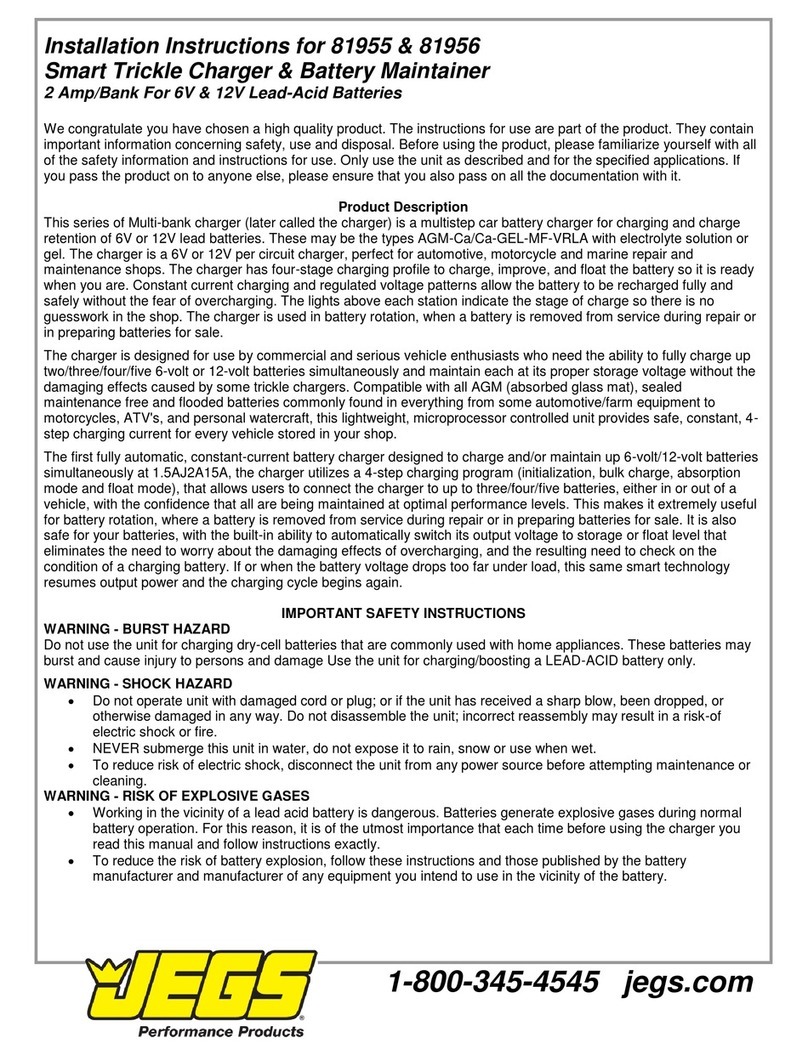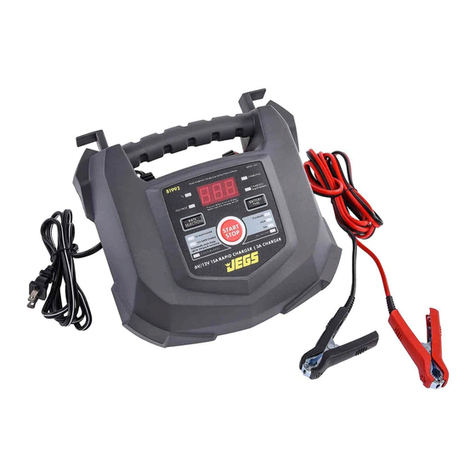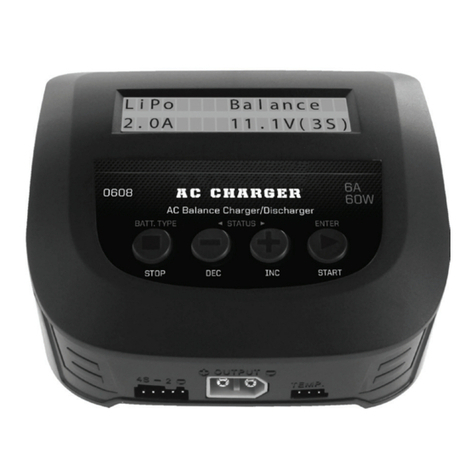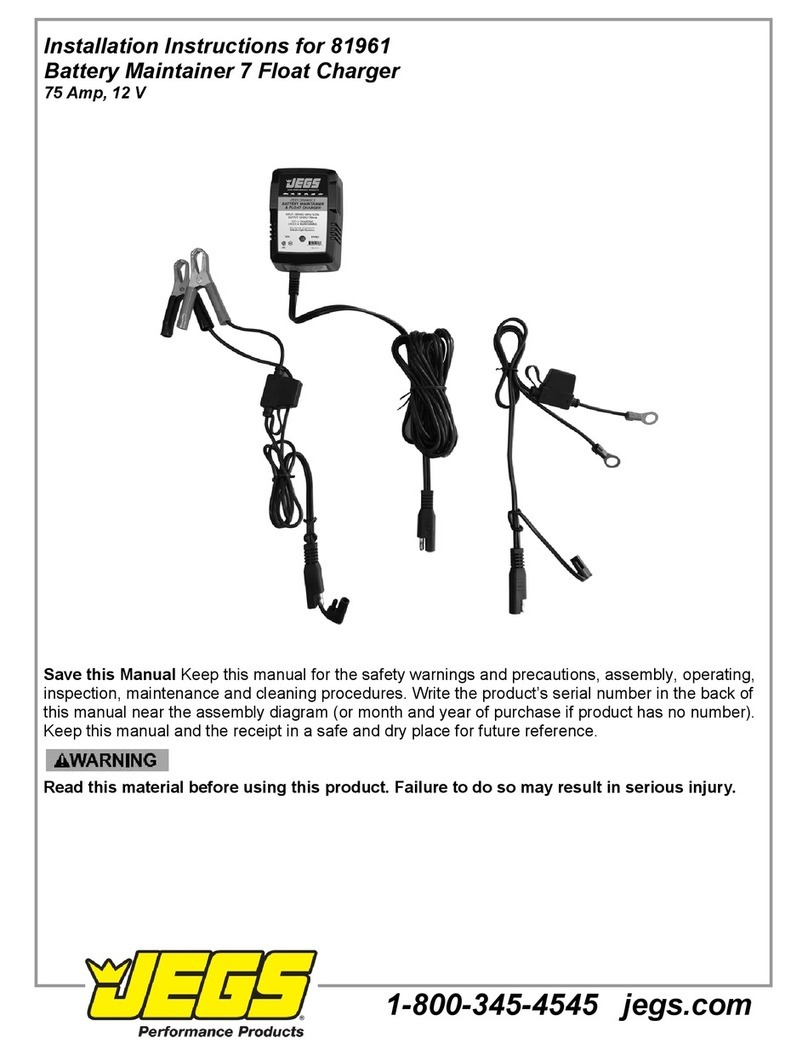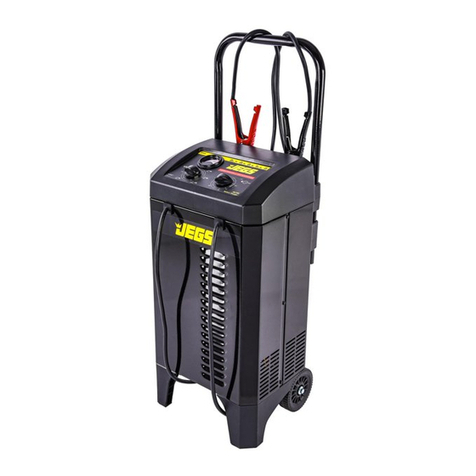Jegs 81954 User manual

• FIRST AID – SKIN: If battery acid comes in contact with skin, rinses immediately with water, then wash thoroughly with soap and water., If redness,
pain, or irritation occurs, seek immediate medical attention.
FIRST AID – EYES: If battery acid comes in contact with eyes, ush eyes immediately, for a minimum of 15 minutes and seek immediate medical attention.
IMPORTANT: Have someone nearby in case of accidents or mishaps.
• Prior to use, read and understand all warnings, cautions and instructions included in all instruction manuals and those published by your vehicle
battery manufacturer.
• Failure to follow all instructions listed in this instruction manual may result in property damage, re, electric shock and/or injury to yourself or others.
• Dry location with overhead cover use only! Do not use maintainer in damp or wet locations. Do not use manitainer in the rain.
• Keep children and non-suspecting persons or pets away from the battery working area.
• Do not force the maintainer. This unit is designed for optimum performance and safety at 3 Amps Charge Rate.
• Never carry the maintainer by the power cord. Keep power cord away from heat, oil, and sharp edges.
• For added safety performance it is recommended that the maintainer be connected to an AC outlet that is protected by a Ground Fault Circuit
Interrupter (GFCI).
• Do not operate the maintainer near ammable materials or any location, which accumulate ammable fumes.
• This product contains chemicals, including lead, known to the State of California to cause cancer and birth defects or other reproductive
harm. Wash hands after handling!
• Battery posts, terminals and related accessories contain lead and lead compounds, chemicals known to the State of California to cause cancer and
reproductive harm. Batteries also contain other chemicals known to the State of California to cause cancer. Wash hands after handling!
• All lead acid batteries (car, truck, boat, etc..) produce hydrogen gas, which may violently explode in the presence of re or sparks, Do not smoke,
use matches, lighters or open ame near batteries.
• Working around lead acid batteries may be dangerous. Lead-acid batteries generate explosive gases during normal charging operations.
• Use this product with 6 or 12 Volt lead-acid batteries only. Do not connect to 24 Volt batteries.
• BURST HAZARD! Do not use this unit to charge dry-cell batteries. These type of batteries may burst and cause injury to persons and property damage.
• Do not submerge this unit in water or expose unit to snow or heavy moisture.
• To reduce risk of electric shock, disconnect the unit from any power source before attempting maintenance or cleaning. Powering OFF controls
without disconnecting will not reduce this risk.
• Do not charge a 6 or 12 Volt lead-acid battery while the vehicle engine is operating.
• Do not operate the maintainer on boats, boat ramps or docks since the electrical power cords and outlets used for connecting could cause
severe electrical shock if they get wet.
• Stay clear of fan blades, belts, pulleys and moving parts that can cause bodily injury during battery charge operations.
• Keep clips battery post connections cables and power cable away from fan blades, belts, pulleys and moving parts during in-vehicle battery
charge operations.
• Wear complete eye and clothing protection. Do not touch eyes while working around lead-acid batteries.
• When connecting or disconnecting the maintainer, pull on the plug not on the power cord.
• Avoid dropping metal tools or objects on top of 6 or 12 Volt batteries. It might spark or short-circuit the battery or other electrical part that may
cause short-circuits or explosion.
• Remove personal metal items, such as rings, bracelets, necklaces and watches while working with lead-acid batteries. It can produce a short-circuit
high enough to cause a severe burn.
• Never charge a frozen battery.
• Never allow battery acid to come in contact with this unit.
• When working with lead acid batteries, always make sure immediate assistances is available in case of accident or emergency.
• Risk of Electric Shock! Do not open unit casing. This product has no user serviceable parts. In the event of operational malfunction or damage, the
unit must be returned to the manufacturer for professional testing and repair. Opening the unit casing will void the manufacturer’s warranty.
• Operate this product in a clear, dry, open and well ventilated area.
• Adult operation only. Not to be operated by children!
• Place unit a minimum of 18 inches above ground level when operating in a garage or similar environments.
• Do not operate this unit with a damage power cord.
• Use only the provided parts or attachments supplied, recommended or sold by the manufacturer specically for use with this unit. Unauthorized
parts may damaged the unit or result in electric shock and bodily injury.
• Save these instructions for future reference.
No. 81954
3A BATTERY MAINTAINER
IMPORTANT SAFETY INSTRUCTIONS
WARNINGS
CAUTIONS
KEYED
CONNECTOR
7.5 AMP
INLINE
FUSE
BATTERY CLIPS
6FT. CABLES
6FT. POWER
CORD
DIGITAL DISPLAY
6 VOLT SELECT
FAULT LED
POWER BUTTON
MANUAL 6V/12V SELECTOR
12 VOLT SELECT

MINIMUM GAUGE FOR CORD SETS
VOLTS
AMPERE RATING
MORE THAN NOT MORETHAN AMERICAN WIRE GAUGE
120 V
0 A
0-25 26-50 51-100 101-150
(0 - 7.6 m) (7.6 - 15.2m) (15.2 - 30.4m) (30.4 - 45.7m)
0-50 51-100 101-200 201-300
(0 - 15.2m) (15.2 - 30.4m) (30.4 - 60.9m) (60.9 - 91.4m)
240 V
TOTAL LENGTH OF CORD IN FEET
6 A
10 A
12 A
6 A
10 A
12 A
16 A
18
18
16
14
14
12
12
16
16
16
12
16
14
14
NOT RECOMMENDED
POWER CORD SAFETY
This unit has a polarized plug (one blade is wider than the other) as a safety feature. This plug will t into a polarized outlet only
one way. If the plug does not t fully into the outlet, reverse the plug. If it still does not t, contact a qualied electrician. Do not
attempt to defeat this safety feature. WARNING: An imporper connection can result in electrical shock.
DIGITAL DISPLAY
6V BATTERY / 12V BATTERY
NOTE: If wrong voltage is selected for 6V battery
(12V charge) “LO” will display.
* Refer to Faults Code Chart on last page.
Displays “LO” when battery capacity is less than 60%.
Displays “60%-90%” when battery voltage goes up gradually.
Displays “FUL” when unit goes into oat charge mode.
Displays Error codes when abnormal conditions occur*.
1.
2.
3.
4.
FEATURES
AUTOMATIC SHUT OFF
This unit is designed to automatically shut o once battery charging is complete to prevent overcharging. When charging is
complete, the digital display will show ”FUL”and the charger has switched to maintenance mode.
MAINTENANCE MODE
Once charging is complete, this unit will automatically go into oat charge mode (also known as maintenance mode). In this mode,
the unit keeps the battery fully charged by delivering a small amount of current, when necessary, to keep the battery at peak charge.
REVERSE POLARITY PROTECTION
If the cables are incorrectly connected to the battery, the red LED indicator will light up and digital display will indicate“F06”.
Note: this unit will not begin charging if the reverse polarity indicator is lit.
OVERHEAT PROTECTION
This unit is designed to shut itself o if overheating is detected. Once the unit cools down, it will resume charging automatically.
CONNECTION METHODS
This unit comes with a standard cables with clips.
3A CHARGE RATE
This unit is recommended for charging small batteries such as those used in motorcycles, ATVs, snowmobiles, personal watercraft,
lawn tractors and golf cars. It is also suitable to maintain larger batteries such as those used in automobile, marine and farm tractors.
LED INDICATOR
A green LED indicates that a 6V battery is being charged.
A green LED indicates that a12V battery is being charged.
A red LED indicates that a fault occurs.
BATTERY MAINTAINER FUNCTIONS
JEGS 3A Battery Maintainer No. 81954 has a charge rate of up to 3 amps. It is designed for charging small batteries and
maintaining large batteries. It is designed for 6 and12 Volt lead-acid batteries only - conventional automotive, maintenance-
free, marine deep cycle and gel - used in cars, farm equipment, boats, RVs and SUVs, lawn mower/garden tractors, motorcycles,
personal watercraft, snowmobiles, ATVs and various application. The JEGS 3A Battery Maintaine features a 3-stage,
high-eciency charging technology, built-in control IC that ensures fast, safe and complete charging of serviceable batteries.
Stage One: Constant Current: When the battery is severely discharged, the battery maintainer applies constant current.
This stage speedily charges the battery while protecting the battery.
Stage Two: Constant Voltage: This is a speed charge cycle for batteries that are nearly fully charged. It will top-o the
battery utilizing a 200mA trickle charge.
Stage Three: Floating Constant Voltage: This stage maintains a fully charged battery in the best condition by constantly
applying a small pulse of charge. The battery voltage will be maintain at approximate 13.5 Volt DC.
OUTDOOR USE EXTENSION CORDS
When the Battery Maintainer is operated outdoors, use only extension cords intended for use outdoors and so marked.
EXTENSION CORDS
Make sure the prongs of extension cord plug are the same number, size and shape as those on this unit and that the
extension cord is in good condition. When using an extension cord, be sure to use one that is rated to carry the current your
product will draw. An undersized extension cord will cause a drop in line voltage resulting in loss of power and overheating.
The following table shows the correct size to use depending on cord length and nameplate ampere rating. If in doubt, use
the next higher rated gage. The smaller the gage number, the higher the amperage load rating of the extension cord.
PREPARING TO CHARGE A BATTERY (6 Volt or 12 Volt)
1. Determine the voltage of the battery to be charged by referring to the vehicle owner’s manual.
2. If it is necessary to remove the battery from a vehicle for charging or for cleaning the terminals/posts, always remove the
battery grounded terminal/post connection rst. Make sure all accessories in the vehicle are o, so as not to cause an arc.
3. Clean battery terminals. Do not allow corrosion to come in contact with eyes.

PREPARING TO CHARGE A BATTERY (6 Volt or 12 Volt) - cont.
4. Add distilled water in each cell until battery acid reaches level specied by the battery manufacturer. This helps purge excessive gas
from cells. Do not overll. For a battery without cell caps (maintenance free), carefully follow manufacturer’s charging instructions.
5. Study all battery manufacturer’s specic precautions, such as removing or not removing caps while charging, and/or
recommended rates of charge.
6. Remove battery completely from boat, airplane or any conned area before charging.
Note: Beware of gas build-up in enclosed areas.
7. Make sure the initial charging rates does not exceed the battery manufacturer’s requirement.
BATTERY MAINTAINER PLACEMENT LOCATION
1. Place the battery maintainer on a clear, dry, stable and level surface.
2. Locate the battery maintainer as far away from the battery as cables permit.
IMPORTANT:
a. NEVER place the battery maintainer directly above the battery being charged, gases from the battery will corrode and
damage the battery maintainer.
b. NEVER allow battery acid to drip onto the battery maintainer when reading specic gravity or lling battery cells.
c. NEVER operate the battery maintainerin a closed-in area or with restrict ventilation in any way.
d. Marine batteries must be removed and charged on shore.
e. Do not set a battery on top of the battery maintainer.
CLIP CONNECTIONS FOR UNINSTALLED BATTERY CHARGING
Before use ensure you have identied battery voltage (6 Volt or 12 Volt)
1. Connect the battery maintainer power cable to an AC receptacle.
2. Select 6 Volt or 12 Volt charging voltage as identied on intended battery to be charged.
3. Check polarity of battery posts. Positive post (marked POS, P, +) usually has a larger diameter than the Negative battery
post (marked NEG, N, -).
4. Attach a 24-inch (minimum length) 6 AWG insulated cable to the Negative battery post (marked NEG, N, -).
5. Connect the Positive (RED) battery clip to the Positive battery post (marked POS, P,+ or Red).
NOTE: Stand as far back from the battery as possible, and do not face battery when making nal connection.
6. Carefully connect the NEGATIVE(BLACK) charger clamp to the free end of the battery cable connected to the negative terminal.
BATTERY MAINTAINER INSTRUCTIONS
IMPORTANT: Ensure that all installations, operating instructions and safety precautions are understood and carefully
followed by anyone installing or using the battery maintainer. Follow the steps outlined in the “Important Safety
Instructions” section of this manual.
1. If the battery is in good status, the digital display will indicate 60-90% that the battery charging capacity (refer to the
Approximate Charging Times section for battery charging durations).
2. As the battery nears full charge capacity, the unit’s output charge rate will automatically drop and“FUL”will show.
3. The battery is fully charged and enters the Stage Three Automatic Float Charging.
AUTOMATIC FLOAT CHARGING
NOTE: Automatic Float Charging is ideal for maintaining a fully charged battery.
1. Keep the 120 Volt AC power and battery connected after the battery is fully charged.
2. The maintainer monitors the battery and tops it o as needed.
ABORTED CHARGE
If charging cannot be completed normally, the unit will abort the procedure. Error message will appear, check the Fault
Codes Chart for troubleshooting. To reset an aborted charge, rst unplug the maintainer from the outlet, chech connection
and fuse, wait a few minutes and plug back again.
DESULFATON
If the battery is left discharged for an extended period, the battery could become sulfated. A sulfated battery will not accept a normal charge.
POWERING‘OFF’AND DISCONNECTING THE BATTERY MAINTAINER
1. When disconnecting the battery maintainer, disconnect the AC power cord, remove clips from vehicle chassis or remote
Negative (NEG,N,-) terminal/post, and then remove the Positive (POS,P,+,RED) clips from the battery.
2. Store the battery maintainer and all accessories.
CLIP CONNECTIONS FOR INSTALLED BATTERY CHARGING
1. Connect the battery maintainer power cable to an AC receptacle.
2. Turn‘OFF’the vehicle ignition and all accessories (e.g., Radio, Lights, Air Conditioning and Cell phones).
3. Set emergency brake and put vehicle with automatic transmission in the‘PARK’position.
5. Determine the polarity of the vehicle battery terminals/posts. The Positive (POS, P, +) battery terminal/post usually is
larger than the Negative (NEG, N, -) terminal/post (if you are unsure consult the vehicle owners manual).
NEGATIVE GROUNDED SYSTEM (MOST VEHICLES)
a. Securely connect the Positive (+) Red clip to the Positive (POS, P,+) terminal/Postof the vehicle battery or the remote Positive (+)
terminal is equipped.
b. Securely connect the Negative (-) Black clip to the vehicle chassis, engine block or a non-moving grounded metal part of
the vehicle as far away from the battery as possible. Do not clamp directly to carburetor, fuel lines, hydraulic lines or
non-grounded sheet-metal body parts.
POSITIVE GROUNDED SYSTEM
a. Securely connect the Negative (-) Black clip to the Negative (NEG, N,-) ungrounded terminal/Post of the vehicle battery.
b. Securely connect the Positive (+) Red clip to the vehicle chassis, engine block or a non-moving grounded metal part of
the vehicle as far away from the battery as possible. Do not clamp directly to carburetor, fuel lines, hydraulic lines or
non-grounded sheet-metal body parts.
IMPORTANT: A marine (boat) battery must be removed and charged on shore. To charge it on board requires equipment

TROUBLESHOOTING / FAULT CODES
FAULT
CODES CAUSE SOLUTION
SPECIFICATIONS
1. UNIT WEIGHT ..1.2 lb.
2. INPUT..................120 Volt AC, 60 Hz, 0.76A
3. OUTPUT .............6 Volt DC, 3 AMP/12 Volt DC, 3 AMP
4. UNIT DIMENSIONS(housing)....1.96 in. (H) x 3.58 in. (W) x 6.50 in. (D)
5. IN-LINE FUSE .................................7.5 AMP-SPADE TYPE (on positive
cable with cover)
© 2017 JEGS.
Made in China.
CUSTOMER SERVICE available 24 hours,
7 days a week. For Questions or comments contact
us at: www.jegs.com or call 1-800-345-4545.
In the unlikely event of a problem with this unit,
do not return it to the place of purchase. Please
contact costumer service at: 1-800-345-4545.
TWO YEAR LIMITED WARRANTY
JEGS is dedicated to making high quality products for every consumer. We are so condent in the quality of our merchandise that we oer a two year limited
warranty with this product. If JEGS concludes that the product is defective during this period, we will repair it or replace it free of charge. Warranty is available
only if original purchase is made in the USA during period covered by warranty. For Customer Service in the USA, visit www.jegs.com or call toll-free at
1-800-345-4545. Please mail all defective products to 101 JEGS Place, Delaware, Ohio 43015. Add a letter with contact information: email address (if you have
one), name, address, telephone number, and problem with product. Do not send any products to JEGS without rst contacting Customer Service.
REPAIR OR REPLACEMENT OFTHE DEFECTIVE PRODUCT OR COMPONENT PROVIDED UNDER THIS WARRANTY SHALL NOT APPLY IF THE PRODUCT: (a) IS
USED FOR COMMERCIAL PURPOSES AND/OR FROM IMPROPER USE IN AN UNSUITABLE ENVIRONMENT (b) IS MODIFIED ORTAMPERED WITH EITHER
INTERNALLY OR EXTERNALLY; (c) IS DAMAGED RESULTING FROM MISUSE, NEGLIGENCE, LACK OF REASONABLE MAINTENANCE AND CARE, OR BY OTHER
CAUSES UNRELATED TO DEFECTIVE MATERIAL OR WORKMANSHIP; (d) IF THE PRODUCT HAS BEEN SUBJECTED TO FIRE,WATER, OR GENERAL CORROSION.
This warranty gives you specic legal rights, and you may also have other rights which vary from State to State in the U.S.A. or province to province in Canada.
WARNING: This product may contain chemicals known to the state of California to cause cancer, birth defects, or other reproductive harm. Wash hands after handling!
APPROXIMATE CHARGING TIMES
The built-in intelligent microprocessor will continuously monitor and adjust the maintainer to provide a fast, safe and
ecient charge. Note that battery charge times will vary depending on several factors including:
Battery State – If a battery has been only slightly discharged, it can be charged in less than a few hours. This same battery
could take up to 10 hours if very discharged.
Battery Rating – A higher rated battery will take longer to charge than a lower rated battery under the same conditions. A
battery is rated in ampere-hours (Ah), reserve capacity (RC) and cold-cranking amps (CCA).
Charge Rate –The charge rate is measured in amps. A battery charged at a lower rate will take longer than a battery charged
at a higher rate. However, smaller batteries can be easily damaged by charging at a rate which is too high for the capacity of
the battery.
Temperature – Cold temperature will aect a batteries ability to accept a charge. Charging in cold temperatures will increase
the amount of time required to charge a battery.
Find your battery’s CCA rating in the table below and note the charging time. The time reects a battery with at least 50%
charge. You may need to add time depending on the severity of discharge.
CARE AND MAINTENANCE
With proper care and minimal maintenance, the JEGS 3A Battery Maintainer No. 81954 will provide years of dependable service.
For maximum performance, manufacturer recommends: After each use, clean the battery maintainer clips - be sure to remove any
battery uid that will cause corrosion on the clips. Always unplug and disconnect unit before cleaning. Clean the outside case of the
maintainer with a soft cloth and, if necessary, mild soap solution. Do not allow liquid to enter the maintainer . Do not operate when
maintainer is wet. Keep the maintainer cords loosely coiled during storage to prevent damage to the cords. Store in cold, dry loaction.
BATTERY RATING / SIZE CHARGING TIME
Small Batteries
(ATV, Lawn Tractor, Motorcycle, etc.)
Marine Deep Cycle
6 – 12 Ah
12 – 32 Ah 2 ½ – 4 hours
5 – 13½ hours
Cars/Trucks
200-315 CCA
315-500 CCA
550-1000 CCA
40 – 60 RC
60 – 85 RC
80 – 190 RC
Maintain only
80 RC /140 RC / 160 RC / 180 RC Maintain only
Ah=Amp Hour
CCA=Cold Cranking Amps
RC=Reserve Capacity
F01 Dead battery. Consult a technician
F02
F03
F04 The maintainer is overheating.
F05
F06 Reverse polarity occurs. Reconnect the battery clips correctly.
An appliance is drawing power from the battery being charged. Disconnect appliance and try to charge again
Use a charger/maintainer with a higher current.
Verify battery and select correct charging voltage. (6 or 12 Volt)
Make sure vents are clear. Unit will resume charging when cooled.
Disconnect the unit with battery and recharge again. Do not use the battery
for other purposes when it is charging. Check the battery conditions.
Charging rate is too small relative to size of the battery.
Maintainer voltage is too high relative to battery.
Consult a technician to check unit.Maintainer error, charge current is higher than selected.
Does not enter the oat stage after 24 hours or the battery
is defective.
FCC NOTE: Please note that changes or modications not expressly approved by the
party responsible for compliance could void the user’s authority to operate the
equipment.
NOTE: This equipment has been tested and found to comply with the limits for a Class B
digital device, pursuant to Part 15 of the FCC Rules. These limits are designed to provide
reasonable protection against harmful interference in a residential installation. This
equipment generates, uses and can radiate radio frequency energy and, if not installed
and used in accordance with the instructions, may cause harmful interference to radio
communications. However, there is no guarantee that interference will not occur in a
particular installation. If this equipment does cause harmful interference to radio or
television reception, which can be determined by turning the equipment o and on, the
user is encouraged to try to correct the interference by one or more of the following
measures: Reorient or relocate the receiving antenna. Increase the separation between
the equipment and receiver. Connect the equipment into an outlet on a circuit dierent
from that to which the receiver is connected. Consult the dealer or an experienced
radio/TV technician for help.

• PRIMEROS AUXILIOS – PIEL: Si el ácido de la batería entra en contacto con la piel, enjuague de inmediato con agua, luego lave bien con agua y jabón.
En caso de enrojecimiento, dolor, irritación, busque atención médica de inmediato.
PRIMEROS AUXILIOS – OJOS: Si el ácido de la batería entra en contacto con los ojos, enjuague de inmediato los ojos durante un mínimo de 15
minutos y busque atención médica de inmediato.
IMPORTANTE: Necesita una persona cerca en caso de accidentes o percances.
• Antes de usar, lea y entienda todas las advertencias, precauciones e instrucciones que se incluyen en este manual de instrucciones y aquéllas que
publica el fabricante de la batería de su vehículo.
• No seguir todas las instrucciones de este manual puede ocasionar daños a la propiedad, incendio, descarga eléctrica y/o lesiones a usted mismo o a otras personas.
• ¡Utilice sólo en un lugar seco y cubierto! No use el conservador de batería en lugares húmedos o mojados. No use el conservador de batería bajo la lluvia.
• Mantenga a los niños y a las personas sin capacidad de discernimiento o las mascotas lejos del área de trabajo del conservador de batería.
• No fuerce el conservador. Este conservador está diseñado para un desempeño óptimo y seguridad en los niveles seleccionables de amperaje de carga.
• Nunca transporte el conservador de batería por el cable de poder. Mantenga el cable de poder alejado del calor, aceite y bordes losos.
• Para un desempeño con mayor seguridad se recomienda que el conservador esté conectado a un tomacorriente de Corriente Alterna que
esté protegido con un interruptor de circuito por falla a tierra (GFCI, por sus siglas en inglés).
• No opere el conservador cerca de materias inamables o en lugares donde se acumulen gases inamables.
• Este producto contiene químicos, incluido plomo, químicos conocidos en el Estado de California como causantes de cáncer y defectos de
nacimiento u otros daños reproductivos. ¡Lávese las manos después de su manejo!
• Los postes de batería, terminales y accesorios relacionados contienen plomo y componentes con plomo, químicos conocidos en el Estado de
California como causantes de cáncer y daños reproductivos. Las baterías también contienen otros químicos conocidos en el Estado de California
como causantes de cáncer. ¡Lávese las manos después de su manejo!
• Todas las baterías de ácido plomo (automóvil, camioneta, bote, etc.) producen gas hidrógeno que puede explotar violentamente en presencia de
fuego o chispas. No fume, ni utilice cerillos, encendedores o llamas abiertas cerca de las baterías.
• Trabajar con baterías de ácido plomo puede ser peligroso. Estas baterías generan gases explosivos durante funcionamiento de carga normal.
• Utilice este producto sólo con baterías de ácido plomo de 6 ó 12 voltios. No conecte a baterías de 24 voltios.
• ¡PELIGRO DE ESTALLIDO! No utilice esta unidad para cargar baterías de celdas secas. Este tipo de baterías puede explotar y causar lesiones a personas
y daños a la propiedad.
• No sumerja esta unidad en agua ni exponga la unidad a la nieve o humedad extrema.
• Para reducir el riesgo de descarga eléctrica, desconecte la unidad de cualquier fuente de potencia antes de intentar el mantenimiento o limpieza.
Los controles del interruptor de apagado sin desconectar la unidad no reducirán este riesgo.
• No cargue una batería de plomo ácido de 6 ó 12 voltios mientras el motor del vehículo esté funcionando.
• No haga funcionar el conservador en botes, rampas de botes o muelles ya que los cables de poder y los tomacorrientes utilizados para
conectar podrían causar una descarga eléctrica severa si se mojan.
• Manténgase alejado de aspas de ventiladores, cinturones, poleas y partes en movimiento que puedan causar lesiones físicas durante el
funcionamiento de la carga de batería.
• Mantenga los cables de las conexiones del poste de batería y pinzas, y el cable de poder lejos de las aspas de ventiladores, cinturones, poleas y
partes en movimiento durante el funcionamiento de carga de la batería en el vehículo.
INSTRUCCIONES IMPORTANTES DE SEGURIDAD
• Use protección total en ojos y ropa. No toque los ojos mientras trabaja con las baterías de ácido plomo.
• Al conectar o desconectar el conservador, jale el enchufe, no jale del cable de poder.
• Evite dejar caer herramientas de metal u objetos sobre baterías de 6 ó 12 voltios. La batería puede causar chispas o un corto circuito, u otra parte
eléctrica puede causar cortos circuitos o explosión.
• Quítese artículos personales de metal, tales como anillos, brazaletes, collares y relojes mientras trabaja con las baterías de ácido plomo. Puede
producir un corto circuito lo sucientemente alto para ocasionar una quemadura severa.
• Nunca cargue una batería congelada.
• Nunca permita que el ácido de la batería entre en contacto con esta unidad.
• Al trabajar con baterías de ácido de plomo, siempre asegúrese de que esté disponible asistencia inmediata en caso de accidente o emergencia.
• ¡Riesgo de descarga eléctrica! No abra la unidad. Este producto no tiene partes que requieran de servicio. En caso de un mal funcionamiento o daño,
la unidad debe devolverse al fabricante para pruebas y reparación profesional. Abrir la unidad anulará la garantía del fabricante.
• Opere este producto en un área despejada, seca, abierta y bien ventilada.
• Solamente un adulto debe hacerlo funcionar. ¡Los niños no deben operar la unidad!
• Coloque la unidad a una distancia mínima de 45,72 cm arriba del nivel del suelo cuando la haga funcionar en una cochera o en ambientes similares.
• No opere esta unidad con un cable de energía dañado.
• Utilice solamente las partes o los accesorios que se proporcionan suministrados, recomendados o vendidos por el fabricante, especialmente para
usarse con esta unidad. Las partes no autorizadas pueden dañar la unidad o causar una descarga eléctrica y lesiones personales.
• Conserve estas instrucciones para futura referencia.
No. 81954
CONSERVADOR DE BATERÍAS DE 3A
ADVERTENCIAS
PRECAUCIONES
CONECTOR
ACUÑADO
FUSIBLE
EN LINEA
DE 7.5 AMP
PINZAS DE
LA BATERÍA
DE 2 METROS
PANTALLA DIGITAL
OPCÍON 6 VOLTIOS
LED DE FALLA
BOTÓN DE PODER
OPCÍON MANUAL 6V/12V
OPCÍON 12 VOLTIOS
CABLE DE PODER
DE 2 METROS
Table of contents
Languages:
Other Jegs Batteries Charger manuals
